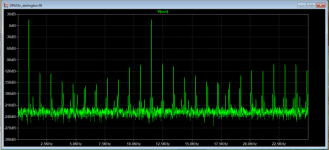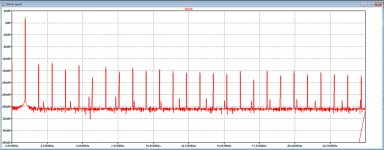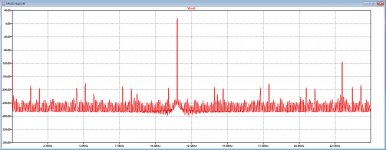Actually in LTSpice THD at 1kHz 9V input is 0.000292%. So that is about 60dB higher than in uCap.LTSpice THD is about 40dB higher than in uCap...
In uC, IMD with IRF series is ~ 20 dB higher than with ECW series (input & bias set properly).
It would be nice to have a universal tracer, producing the models via actual measurement of "device in possession".
Anyhow, the topology with the OPA552 looks viable.
It would be nice to have a universal tracer, producing the models via actual measurement of "device in possession".
Anyhow, the topology with the OPA552 looks viable.
With three MosFet models used, resp the IRFP series from Bob Cordell, The ECW series from uCap and finally the ECW series from Heglun&Keantoken I got the following spectra, all with the same input and all with 250mA Bias.
The uCap seems too optimistic and the other two are showing practically the same distortion peaks.
The ECW's are quite a bit noisier, but at a total insignificant level.
Hans
The uCap seems too optimistic and the other two are showing practically the same distortion peaks.
The ECW's are quite a bit noisier, but at a total insignificant level.
Hans
Attachments
If uC models for the ECW series are too optimistic, that must be the case for other laterals too (2SK1058 etc.) as the difference in circuit behavior mainly considers R(on) / Id(max). What looks like noise in the lower two pics could be high order IMD products instead. In that case, the difference between adjacent peaks is 50 Hz. If so, the model from Bob Cordell is too optimistic. It would be interesting to use darlingtons instead of mosfets.
I agree that the Grass below -200dB could very well be IMD, but the conclusion that the Cordell model is too optimistic is questionable.
Hans
Hans
It would need measurements to be sure. Hence, presuming the topology is valid, I exchanged the mosfets with darlingtons (much cheaper too), setting quiescent current to proper value. THD 1k & 20k. It would be interesting to see if that's too good to be true as well.


Not so much problems for followers.Cgs is much higher too so driver influence can't be neglected.
If you had the bad experiences I encountered decades ago specially with darlingtons, you would not consider them at all. But hey, you are on a theoretical sportive challenge, far away from practical relevance. 😉
Bad experiences are worthwhile to tell. While I can imagine some thermal issues, I would wonder how STD03N and STD03P would behave.
But no problem using discretes either, I often use BD139/140 and DH44/45 in sims.
But no problem using discretes either, I often use BD139/140 and DH44/45 in sims.
I was referring specially to integrated darlingtons in one housing with 3 terminals like any other transistor, not the discrete darlington topology. I assume it was their bad turnoff-behaviour that made them quite unreliable in the field.
That bad behavior shows well even with uC, using types like the MJH6284 / 7 in sims of power stages, at 20 KHz. Those darlingtons are only good in a sim of "worst case possible". The STD03 is better in that respect, and so is the MN2488 (Ft 55MHz) and its complementary part, MP1620 (Ft 50 MHz).
With darlingtons IMD is about 30dB higher than with mosfets.I exchanged the mosfets with darlingtons (much cheaper too), setting quiescent current to proper value.
Attachments
With a proper set of BJT's, result is comparable to the IRFP Mosfets version.
I also made a run for just 950Hz and 11.5Khz, to find the reason for the "Grass".
To my surprise THD for 950Hz with TI's model is much larger without any decay as for 11.5Khz, and when doing the IMD test, all these harmonics are again creating IMD products.
It's wise not to jump to conclusions, because many models aren't that perfect below -120dB, so in real life things may be rather different.
Hans
I also made a run for just 950Hz and 11.5Khz, to find the reason for the "Grass".
To my surprise THD for 950Hz with TI's model is much larger without any decay as for 11.5Khz, and when doing the IMD test, all these harmonics are again creating IMD products.
It's wise not to jump to conclusions, because many models aren't that perfect below -120dB, so in real life things may be rather different.
Hans
Attachments
MJH6284 and 6287 are about the worst choice for a darlington. So I also ran a sim with a combination resembling STD03N and STD03P at ~ 100 mA Quiescent current.

- Home
- Amplifiers
- Solid State
- Musings on amp design... a thread split




